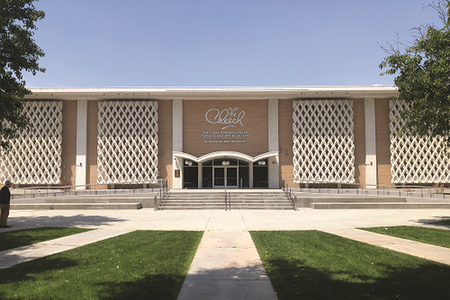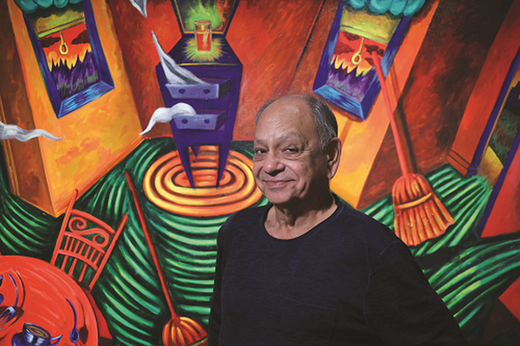The Art of Identity

He began his collection in the 1980s after realizing his celebrity status could call attention to what he saw as an under-appreciated and under-represented genre of art. He now has acquired more than 700 works, making it the largest collection of Chicana/o/x art in the world. The collection toured contemporary art institutions across the country to enthusiastic reception and record-breaking crowds, validating Marin’s vision of Chicana/o/x art as a significant and legitimate American art movement.
A successful exhibit of Marin's collection at the Riverside Art Museum (RAM) in early 2017 sparked an interest in establishing a permanent home for the collection in Riverside. Marin liked the idea of keeping the collection intact and the city of Riverside, with its recognition of history, art and culture, as well as a large Latino population and five universities in the area, proved to be an ideal location.
In a public-private collaboration with the city of Riverside, who provided the building, and RAM, who manages the new museum, The Cheech Marin Center for Chicano Art & Culture opened in June 2022. Known simply as The Cheech, the center is dedicated to the presentation and study of Chicana/o/x art, and the exploration of its social, cultural and political impact. It is the first North American facility dedicated to Mexican-American art.
The Cheech is sandwiched between the Riverside Art Museum and the historic Mission Inn, marking a significant addition to the “City of Arts and Innovation” cultural renaissance of downtown Riverside. The midcentury modern home of The Cheech was previously the Riverside public library, which moved to a new downtown location in 2020. Completely renovated and stripped down to concrete floors, brick walls and exposed beams, the newly created galleries are urban and modern; large, open spaces well-suited for a variety of exhibits. An auditorium, video gallery and education center provide spaces for special programs and classroom activities.
Public reception to The Cheech has been overwhelmingly positive, with first-year attendance far exceeding initial estimates.
“Over 135,000 people visited The Cheech last year, well over our goal. It’s a testament to the kind of work we are doing, guiding our work as we move forward to do more of what is needed,” shares Drew Oberjuege, Executive Director of the Riverside Art Museum.

Prior to the 1960s, Mexican-Americans had suffered decades of discrimination and oppression in the U.S. West and Southwest. In the early 1960s, the radicalized Chicano Movement began pushing for a new Mexican-American identification, advocating social and political empowerment through a chicanismo or cultural nationalism. Those in the Chicano Movement gave up assimilation efforts and instead actively embraced their full heritage, not only recognizing their Spanish or European background but also celebrating their Indigenous and African roots.
Chicano art evolved as a reflection of the people and the community and their struggles for respect and equality. Typically vibrant and colorful, it showcases the lives, needs and politics of the people, providing voices to a population that is often still marginalized and silenced. Common themes are family, the cultural influences of the Mexican-American community, political statements and challenges facing immigrants. Many works explore identity and abstract representations of modern Chicano life.
The growing archive of the Chicano art movement serves as a visual record of the community and is also an invaluable resource for the cultural education and understanding of Chicano heritage. The Cheech has provided fresh opportunities for community engagement through special exhibitions, free public programs, art talks, performances, film screenings and lectures. Faculty and staff from local higher education institutions, such as UC Riverside, Cal State San Bernardino and Riverside Community College, have supported The Cheech in developing special exhibitions, lectures and art demonstrations.
“The Cheech isn’t just another multicultural moment. It is a call for substantive change in museums to represent their communities more fully,” notes María Esther Fernández, Artistic Director of The Cheech Marin Center for Chicano Art & Culture.
That is a mission The Cheech takes seriously. Opening in February 2024, a retrospective of acclaimed Chicana artist Judithe Hernández is the first such exhibit organized by The Cheech. “It is the work of the center to support these kinds of long-overdue retrospectives,” Fernandez sai
Currently on view at The Cheech
On the first floor of The Cheech is “Indigenous Futurism,” which features work by 18 all-femme artists throughout California who explore their ancestral roots; and “Cheech Collects: Anniversary Edition,” which includes selections from Cheech’s notable collection. Upstairs, through January 7, 2024 is “Xican-a.o.x. Body” organized by the American Federation of Arts. Opening in February 2024, a retrospective of Judithe Hernández.
The Cheech Marin Center for Chicano Art & Culture
3581 Mission Inn Avenue
Riverside, CA 92501
951.684.7111
thecheechcenter.org
riversideartmuseum.org
Open Tuesday to Sunday, 10 a.m. to 5 p.m. Admission is timed and capacity is limited. Free admission on first Thursday of the month from 6 to 9 p.m. and first Sunday of the month, October to May, 1 to 4 p.m.



